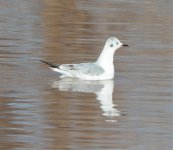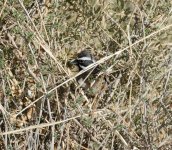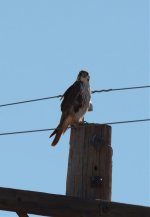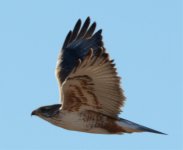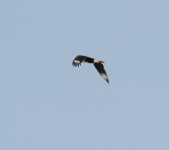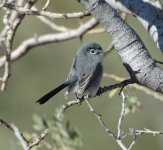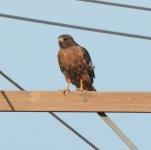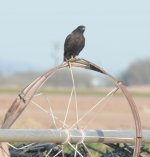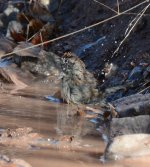-
Welcome to BirdForum, the internet's largest birding community with thousands of members from all over the world. The forums are dedicated to wild birds, birding, binoculars and equipment and all that goes with it.
Please register for an account to take part in the discussions in the forum, post your pictures in the gallery and more.
You are using an out of date browser. It may not display this or other websites correctly.
You should upgrade or use an alternative browser.
You should upgrade or use an alternative browser.
Arizona USA (1 Viewer)
- Thread starter Chris1973
- Start date
More options
Who Replied?Tiraya
San Diego CA

Agree.Bonapartes Gull
Black-throated Sparrow
Prairie Falcon
Ferruginous Hawk
The Falcon
Registered Birder
I agree also.
Chris1973
Well-known member
Thank you. Adding some more from Southern Arizona during December. Guesses: 1. Crested Caracara, 2. Black-tailed Gnatcatcher, 3. Rufous Red-tailed Hawk, 4. Dark Red-tailed Hawk, 5. Rufous-crowned Sparrow.
Thanks!
Thanks!
Attachments
Chris1973
Well-known member
I'm pretty sure your Gnatcatcher is a Blue-gray Gnatcatcher.
Thank you. My rationale for Black-tailed was the black streak over the eye and the fact that it was with its mate in desert scrub which according to Sibley's is indicative of Black-tailed. Of course you might be right.
I don't think picture 4 is a Red-tailed Hawk. It could be a Common Black Hawk with it's totally black forehead. And it is perched on irrigation equipment near water where they like to hunt for amphibians.
Further comment: I have been going back and forth among my books comparing this bird with the Common Black Hawk and the Zone-tailed Hawk, and because the bird is perched it is tough!:h?:
Range maps in the Crossley guide show them to be located the same places in Arizona and notes in Wheeler's Western guide put them in the same kinds of places.
Is there a better picture of it showing it's beak and cere? Or better yet did you get a picture of it soaring? They have big differences in their shapes there.
Bob
Further comment: I have been going back and forth among my books comparing this bird with the Common Black Hawk and the Zone-tailed Hawk, and because the bird is perched it is tough!:h?:
Range maps in the Crossley guide show them to be located the same places in Arizona and notes in Wheeler's Western guide put them in the same kinds of places.
Is there a better picture of it showing it's beak and cere? Or better yet did you get a picture of it soaring? They have big differences in their shapes there.
Bob
Last edited:
ovenbird43
Well-known member

I don't have any field guides handy at the moment, but the gnatcatcher looks good for Black-tailed, and the habitat sounds spot-on- I haven't encountered Blue-gray in the desert in winter.
Not going to comment on the dark hawk without field guides, but Common Black-Hawk is unlikely (but probably not impossible) given the time of year.
Not going to comment on the dark hawk without field guides, but Common Black-Hawk is unlikely (but probably not impossible) given the time of year.
DarkFireFalcon
Well-known member
a dark Red-tail is by far the most likely, given the habitat (flat agricultural lands). Zone-tails are more in the mountains (and I don't see much of a bright yellow cere).
Chris1973
Well-known member
Is there a better picture of it showing it's beak and cere? Or better yet did you get a picture of it soaring?
Sadly no. It stayed perched and was very far from the road on private lands. I assumed Red-tailed based on what is the most likely to be in this area and habitat in Winter.
It could be a Dark Morph Western RTH although they aren't common.
The Crossley Guide says that "A small percentage (5-10%) of dark-morph adults are uniformly brown underneath." p205. Clark and Wheeler's Photographic Guide says that Dark and Rufous morphs in "Western" RTHs are "only as a small fraction." p.82. Wheeler's Western Guide says "Uncommon. In winter, more common east of the Rocky Mts. Comprises 5-10% of the population." p.338.
The cere on this one looks greenish in this photograph but they can also have yellowish ones. Tarsi are certainly big enough.
Bob
The Crossley Guide says that "A small percentage (5-10%) of dark-morph adults are uniformly brown underneath." p205. Clark and Wheeler's Photographic Guide says that Dark and Rufous morphs in "Western" RTHs are "only as a small fraction." p.82. Wheeler's Western Guide says "Uncommon. In winter, more common east of the Rocky Mts. Comprises 5-10% of the population." p.338.
The cere on this one looks greenish in this photograph but they can also have yellowish ones. Tarsi are certainly big enough.
Bob
TLeukering
Well-known member
The two dark raptors are both adult Red-tailed Hawks, one a rufous bird, the other black. Common Black-Hawk has a distinctively large and yellow cere that expands into the face, a feature lacking on the pictured bird. It also has a deeper-based bill.
The black lateral crown stripe of the gnatcatcher is too extensive behind the eye to be a Western Blue-gray (which is what it would almost have to be in Arizona) and the black behind the eye suggests that this is a male Black-tailed coming into alternate plumage. The habitat is also good for Black-tailed.
The black lateral crown stripe of the gnatcatcher is too extensive behind the eye to be a Western Blue-gray (which is what it would almost have to be in Arizona) and the black behind the eye suggests that this is a male Black-tailed coming into alternate plumage. The habitat is also good for Black-tailed.
Users who are viewing this thread
Total: 2 (members: 0, guests: 2)




